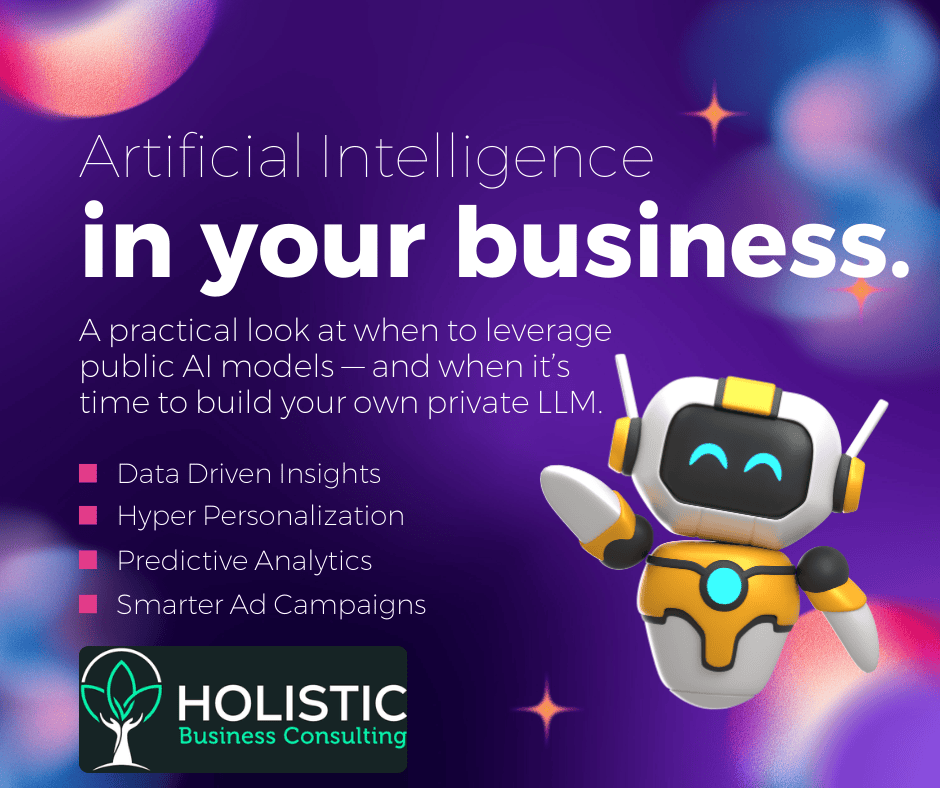A practical look at when to leverage public AI models — and when it’s time to build your own private LLM.

This week, after several discussions with current and prospective clients about implementing AI while traveling for HBC, it seemed fitting to share our perspective. Much of the industry is flooded with hype around “public” services like ChatGPT, Gemini, Perplexity, etc. But when we work with clients, we dive deep to understand their unique needs—getting AI wrong today can cost you big tomorrow. Are we perfect at it? No. Is anyone? Not yet… We’re all learning and love tackling your unique challenges.
Ever wondered whether to plug into ChatGPT, Perplexity, Gemini—or spin up your own private LLM? Both approaches can supercharge your apps, but the trade‑offs are real. Here’s how we think about it when advising our clients, with a few extra details and real‑world considerations thrown in.
Pre‑Built AI: Hit the Ground Running
What it is
Ready‑made, cloud‑hosted models from OpenAI, Google, Perplexity, and friends. You point your code at an API endpoint and—in minutes—you’ve got conversational agents, document summarizers, and more.
How clients use it
Customer support chatbots that auto‑triage tickets and draft answers
Content generation pipelines for marketing—blogs, social posts, product descriptions
Data exploration assistants that ingest CSVs or databases and deliver plain‑English summaries
Why we like it
Fast wins. Integration via REST or SDK takes hours, not weeks.
Always improving. Providers roll out model upgrades (GPT‑4 → 4.5 → 5) without you lifting a finger.
Ops‑free scaling. Built‑in load‑balancing, high availability, and regional endpoints for lower latency.
Managed privacy features. Many vendors now offer data‑residency zones or “no‑log” options for sensitive calls.
Where it bites
Data control. Even with “no‑log” promises, your prompts and context pass through someone else’s network.
Limited customization. Fine‑tuning is often minor; you can’t tweak model architecture.
Budget surprises. A viral campaign or broad rollout can turn predictable OpEx into sticker‑shock token bills.
Dependency risk. API changes, rate limits, or sudden pricing revisions can force emergency rewrites or budget reallocations.
Private LLM: Your Own Playground
What it is
Pick a base model—open‑source (LLaMA, Falcon) or enterprise‑licensed (Anthropic, Cohere)—then host inference in your own cloud or on‑prem. Build the fine‑tuning, retrieval‑augmented pipelines, monitoring, and autoscaling yourself.
How clients use it
Regulated environments (finance, healthcare) where data egress must be zero.
Consulting firms embedding proprietary methodologies so the LLM “speaks their dialect.”
High‑volume batch tasks (bulk summarization, OCR‑to‑insights) where per‑token API fees would be prohibitive.
Why we love it (for the right use cases)
Total ownership. Full control over model weights, training data, and inference code.
Deep customization. Adjust layer sizes, train on your internal wikis, embed custom tools via LangChain or your own microservices.
Compliance proof‑points. Easier to certify against HIPAA, GDPR, FedRAMP when everything stays in your VPC.
Cost efficiencies at scale. Once your cluster’s running, extra queries add marginal GPU‑hour costs, not per‑token fees.
Where it hurts
Up‑front investment. Expect six‑figure bills for GPUs, storage, and hiring MLOps talent to build pipelines.
Time to market. From spinning up servers to hardening CI/CD, it can take 8–16 weeks before you push to prod.
Ongoing MLOps work. You own patching, drift detection, retraining schedules, auto‑scaling rules—and the on‑call pager.
Keeping up with research. New architectures (mixture‑of‑experts, multi‑modal, retrieval‑augmented) drop constantly; build a roadmap for regular upgrades.
Choosing Your Path
Proof‑of‑Concepts & Side Projects
Go hosted. Spin up ChatGPT or Gemini in hours. Validate UX flows, measure impact, then decide if it’s worth building your own.
Regulated or IP‑Heavy Workloads
Go private—or hybrid. Keep PII and trade secrets in your LLM; use hosted APIs for non‑critical tasks like public‑facing chatbots.
High‑Volume, Predictable Usage
Crunch the numbers. If you forecast millions of monthly calls, run the TCO: API token costs vs. GPU‑hour amortization. Often an on‑prem cluster pays for itself by month six.
Long‑Term AI Strategy
Invest in-house if AI is core. Build a small center of excellence to own your private model’s roadmap. Otherwise, outsource the heavy lifting and focus on integrating insights into your products.
No one‑size‑fits‑all here. Most savvy teams settle on a hybrid approach—leveraging hosted models for speed and general tasks, while reserving private LLMs for mission‑critical, data‑sensitive workloads.
Ready to map out the best fit for your business? Drop us a line, and let’s architect an AI strategy that scales, secures, and sets you apart.

